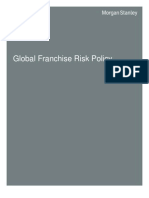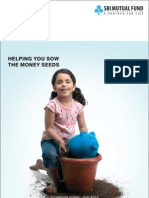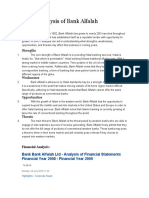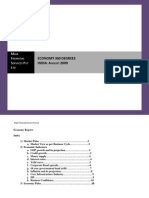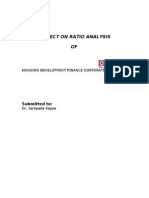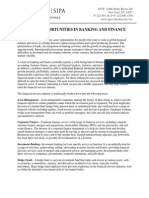KOtak Recommendation V2
KOtak Recommendation V2
Uploaded by
Biswa1983Copyright:
Available Formats
KOtak Recommendation V2
KOtak Recommendation V2
Uploaded by
Biswa1983Copyright
Available Formats
Share this document
Did you find this document useful?
Is this content inappropriate?
Copyright:
Available Formats
KOtak Recommendation V2
KOtak Recommendation V2
Uploaded by
Biswa1983Copyright:
Available Formats
Hold
Bank
Kotak Mahindra
12th Sept, 2011
CMP: 453 Fiduciary Euromax Capital Markets Pvt. Ltd.
Key Highlights Poised to witness above-average growth: We expect KMB to continue beating industry advance growth rates by a significant margin. Aided by robust (~29%) loan book growth and high NIMs (~5.2%) over the next two years, supported by the groups asset mix (albeit some margin pressure in the medium term) we expect KMB to record healthy growth in NII going forward. Robust CAR presents solid ground for loan book growth: KMB reported a robust capital adequacy ratio (CAR) of 19.5% and a Tier I capital ratio of 18.1% as at 31 March 2011 on a consolidated basis. This will support balance sheet growth going forward without the need for raising fresh capital in the foreseeable future and also allow the bank to grow its return on equity (RoE) going forward. Financial supermarket model provides diversification: KMBs financial supermarket model gives it the advantage of exploiting the growth potential of various financial services verticals outside of traditional banking and opens up significant cross-selling opportunities. Further, as the bank generates a significant proportion of its income from non-balance sheet businesses it generates higher return on assets (RoA) compared to its peers. Company Description: Incorporated in 1985 as Kotak Capital Management Finance Ltd. and rechristened Kotak Mahindra Finance Ltd. a year later, the company started bill discounting activities in 1986. The company entered upon the lease and hire purchase business in 1987 and in 1990 it commenced its car finance operations. In 1991, the companys investment banking division was started and in the same year it took over FICOM, one of India's largest financial retail marketing networks. In 2003, the company commenced full-fledged banking operations as Kotak Mahindra Bank Ltd. (KMB) after receiving a license from the Reserve Bank of India (RBI). Today KMB is a financial supermarket offering a wide range of services such as banking, car finance, life insurance, securities broking, investment banking and asset management. KMB operates the commercial banking business of the group and is also the holding company of 16 subsidiaries managing the other businesses of the company. KMB also holds a majority stake in its life insurance joint venture (JV) with Old Mutual Plc. As at 31 March 2011 the bank had 321 branches and 710 ATMs. KMB is the fourth largest private bank in India in terms of market capitalization.
Fiduciary Euromax Capital Markets Pvt. Ltd. Bank
Kotak Mahindra
Exhibit 1: Financial Summary
Day's High / Low Previous Close / Open Weekly H/L Monthly H/L 52 Weeks H/L
484.00 / 470.00 479.85 / 482.00 484 / 484 / 529.5 / ( 14 Oct 10 )
449 411.2 333.25 ( 9 Feb 11 )
Financial Projections (in Million) Revenue Net Profit EPS PE CAR (standalone) NPM (standalone) %
FY11 83948 15667 21.73 43.6 19.92
FY12E 77930 18187 24.28 35.5 18.15 23.33
FY13E 93628 22013.6 29.65 29.2 19.92 20.18
% 18.66
Shareholding Pattern (in %) Promoter FII DII Others
11-Jun 45.51 26 5.4 23.09
11-Mar 45.57 25.4 5.44 23.59
10-Dec 45.61 23.99 5.84 24.56
Page 2 of 6 Biswajeet J. Pattnaik, biswajeet@fegroup.in
Fiduciary Euromax Capital Markets Pvt. Ltd. Bank
Kotak Mahindra
Exhibit 2: Shareholding pattern (exceeding 1%)
Sl. No.
Key Strengths
Poised to witness above-average growth
KMBs loan book grew by a robust CAGR of 32% compared with an industry average of 21% between 2006 and 2011. The banks deposit base grew at a CAGR of 37% during the same period compared to an industry average of 20%. KMBs NIMs have always been higher than most of its peers, attributable to its asset mix with significant presence in high yielding segments such as car finance, and commercial vehicle (CV) and commercial equipment (CE) finance (car finance: 21%; CVs & CEs: 15% as at the end of FY 2011). The bank, historically, had a
Name Shareh Sumitom Banking Corporati
Page 3 of 6
Biswajeet J. Pattnaik, biswajeet@fegroup.in
Fiduciary Euromax Capital Markets Pvt. Ltd. Bank
Kotak Mahindra
relatively high exposure to retail loans, which over the past few years has reduced (FY 2011: 3% vs. FY 2008: 14%). For FY 2011, KMB reported an NIM of 5.8% on a consolidated basis. We expect NIM to be pressured a bit during FY 2012 due to higher cost of funds. In general, too, we expect NIMs to trend lower than the high historical levels (FY 2010: 6.1%) as the bank increases exposure to lower yielding asset classes such as corporate and mortgage loans; nonetheless, we expect consolidated NIM to remain above 5% over the next couple of years. Robust CAR presents solid ground for loan book growth KMB reported a robust capital adequacy ratio (CAR) of 19.5% and a Tier I capital ratio of 18.1% as at 31 March 2011 on a consolidated basis. This will support balance sheet growth going forward without the need for raising fresh capital in the foreseeable future. We expect the advances to grow by an average of ~29% annually over the next couple of years, a rate substantially higher than the expected rate of growth for industry advances. The banks strong capital position will also allow it to grow its return on equity (RoE) going forward. Financial supermarket model provides diversification KMBs financial supermarket model gives it the advantage of exploiting the growth potential of various financial services verticals outside of traditional banking. This model also opens up significant cross-selling opportunities with the group having presence in a gamut of services in both the retail as well as corporate markets. Further, as the bank generates a significant proportion of its income from non-balance sheet businesses (noninterest income contributed 58% of total income in FY 2011) it generates higher return on assets (RoA) compared to its peers. KMB also has a well established agricultural lending business (~10% of loan book at the end of FY 2011) which is profitable and has witnessed robust growth. Its agri portfolio has also enabled the bank to consistently meet its priority sector lending (PSL) targets which in turn has resulted in the bank not requiring putting significant amounts of money into the low-yielding Rural Infrastructure Development Fund (RIDF). Subsequently, this has contributed positively to the high NIMs of the bank. Further, this has also enabled the bank to restrict its microfinance institution (MFI) exposure to ~0.2% of total advances. Key Risks Any deterioration of the overall economic environment may lead to slower credit off take an increase in slippages compared to what have been modeled into our forecasts, thereby negatively impacting profits. As KMBs asset mix consists of a high proportion of high-yield assets, a worsening of the economic environment is likely to impact KMB more than the banks having a greater proportion of low-yield, and thereby less risky, assets on its books. Kotak is heavily exposed to capital markets, via retail and institutional brokering, investment banking, and third-party funds distribution. We believe, however, that it may not be able to exploit these opportunities as well as it had in the past because: BrokeringYields and market share are declining: Market share and yields in the online brokering business are trending down, with increased competition and further geographical penetration decelerating. Investment banking: Activity is picking up but float income could be lower: The investment banking business is likely to see tighter margins this time around, especially with float
Page 4 of 6 Biswajeet J. Pattnaik, biswajeet@fegroup.in
Fiduciary Euromax Capital Markets Pvt. Ltd. Bank
Kotak Mahindra
income being capped by tighter regulation. Also, the number of days of float income is also being capped and this would further put pressure on revenue from IB. Distribution fees under pressure: Third-party distribution income is also under pressure, with front-end fees restricted on mutual funds and overall fees capped on life insurance.
Quarterly update Kotak Mahindra bank had delivered a mixed quarter. Standalone basis, its NII growth was somewhat disappointed on the back of NIMs compression. The CASA share has declined by 300 bps QoQ and 100 bps YoY to 27%. However this was mitigated by higher non-interest income growth better cost efficiency. Asset quality improved on QoQ as well as YoY basis. Lowers provisions had supported PAT. Bank had 323 full-fledged bank branches (262 branches as on June 30, 2010) across 184 locations and 725 ATMs. On the consolidated basis, top line & bottom-line was slightly disappointing on sequential basis. Consolidated NIM for Q112 stood at 5.0% (Q111 5.4%). Consolidated capital adequacy ratio (CAR) excluding profit for Q1 FY12 as per Basel II as on June 30, 2011 is 18.4%. Tier 1 ratio is 16.9%. Asset quality improved on consolidated basis too. Other details are as follows
Kotak Mahindra Bank Ltd. -Standalone- [INR-Millions] DESCRIPTION Q1'12 Q4'11 Q1'11 QoQ% YoY% Interest Earned 13297.82 12326.32 9208.03 7.9% 44.4% Interest Expended 7619.32 6110.65 4126.10 24.7% 84.7% NII 5678.50 6215.67 5081.93 -8.6% 11.7% Other Income 2286.62 1912.98 1370.73 19.5% 66.8% Total Income 7965.12 8128.65 6452.66 -2.0% 23.4% Operating Expenses 4104.56 4448.94 3299.24 -7.7% 24.4% Operating Profit before Prov.& Cont. 3860.56 3679.71 3153.42 4.9% 22.4% Provisions and Contingencies 220.85 -71.73 560.95 NA -60.6% PBT 3639.71 3751.44 2592.47 -3.0% 40.4% Tax 1119.36 1264.42 723.44 -11.5% 54.7% Net Profit (after Extraordinary Items) 2520.35 2487.01 1869.03 1.3% 34.8% Adj Calculated EPS 3.42 3.38 2.68 1.2% 27.6% Ratios% Q1'12 Q4'11 Q1'11 in BPS in BPS Capital Adequacy Ratio Basel II 18.15 19.92 16.79 -177.00 136.00 % of Net NPAs 0.66 0.72 1.33 -6.00 -67.00 % of Gross NPAs 1.88 2.03 3.29 -15.00 -141.00 Return on Assets 0.47 0.50 0.45 -3.00 2.00 Cost to Income 51.53 54.73 51.12 -320.00 41.00 CASA% 27.0 30.0 28.0 -300.00 -100.00 Kotak Mahindra Bank Ltd. -Consolidated- [INR-Millions] - NOT RATED DESCRIPTION Q1'12 Q4'11 Q1'11 QoQ% Interest Earned 18696.09 17227.10 12786.69 8.5% Interest Expended 9492.36 7743.62 5254.39 22.6% NII 9203.73 9483.48 7532.30 -2.9% Other Income 8610.32 13050.78 10626.70 -34.0% Total Income 17814.05 22534.26 18159.00 -20.9% Operating Expenses 11547.50 15488.65 12898.74 -25.4% Operating Profit before Prov.& Cont. 6266.55 7045.60 5260.26 -11.1%
YoY% 46.2% 80.7% 22.2% -19.0% -1.9% -10.5% 19.1%
Page 5 of 6
Biswajeet J. Pattnaik, biswajeet@fegroup.in
Fiduciary Euromax Capital Markets Pvt. Ltd. Bank
Kotak Mahindra
Provisions and Contingencies PBT Tax Profit After Tax Minority Interest Shares of Associates Consolidated Net Profit Adj Calculated EPS Ratios% % of Net NPAs % of Gross NPAs Return on Assets Cost to Income
241.62 6024.93 1831.27 4193.66 -120.34 87.69 4161.01 5.64 Q1'12 0.54 1.59 0.55 64.82
-85.71 7131.32 2076.70 5054.62 -185.16 44.32 4913.78 6.67 Q4'11 0.59 1.71 0.68 68.73
552.90 -381.9% -56.3% 4707.36 -15.5% 28.0% 1510.58 -11.8% 21.2% 3196.78 -17.0% 31.2% 17.97 -35.0% -769.7% 62.19 97.9% 41.0% 3276.94 -15.3% 27.0% 4.70 -15.4% 20.0% Q1'11 in BPS in BPS 1.19 -5.00 -65.00 2.79 -12.00 -120.00 0.56 -13.00 -1.00 71.03 -391.00 -621.00
Exhibit 3: Other Subsidiaries performance
Investment Opinion Since there is a huge dependence on the capital markets for its profitability, and it is one of the few stocks to return at the price at which we left, I think a position of 3000 shares initially and incrementally increasing the position depending on the current market scenario.
Page 6 of 6 Biswajeet J. Pattnaik, biswajeet@fegroup.in
You might also like
- Goldman Sachs CEEMEA in Focus Nigeria - Turning The CornerDocument9 pagesGoldman Sachs CEEMEA in Focus Nigeria - Turning The Cornerkossyella848No ratings yet
- GS-Apple VR AR Headsets 20230522Document9 pagesGS-Apple VR AR Headsets 20230522風雲造天No ratings yet
- Global Franchise Risk Policy 2011 FINALDocument12 pagesGlobal Franchise Risk Policy 2011 FINALbcappp100% (1)
- DD309 ATMA2016 FirstDocument4 pagesDD309 ATMA2016 FirstLong Dong MidoNo ratings yet
- Black Book BbiDocument84 pagesBlack Book BbiVikas Shah67% (3)
- The State Bank of IndiaDocument4 pagesThe State Bank of IndiaHimanshu JainNo ratings yet
- Mauritius Commercial Bank: RatingDocument10 pagesMauritius Commercial Bank: RatingMowjsing YuvanNo ratings yet
- Kotak BankDocument44 pagesKotak BankPrince YadavNo ratings yet
- Equity Research: (Series IV) 10th August 2012Document18 pagesEquity Research: (Series IV) 10th August 2012kgsbppNo ratings yet
- (Kotak) ICICI Bank, January 31, 2013Document14 pages(Kotak) ICICI Bank, January 31, 2013Chaitanya JagarlapudiNo ratings yet
- P PP P PP GPPP: Key Points Financial Year '10 Prospects Sector Do's and Dont'sDocument7 pagesP PP P PP GPPP: Key Points Financial Year '10 Prospects Sector Do's and Dont'sTeja YellajosyulaNo ratings yet
- When The Gap Between Perception and Reality Is The Maximum, Price Is The Best''Document20 pagesWhen The Gap Between Perception and Reality Is The Maximum, Price Is The Best''sukujeNo ratings yet
- SWOT Analysis of Banking SectorDocument6 pagesSWOT Analysis of Banking SectorMidhun RajNo ratings yet
- Swot Analysis Indian Banking: From The Selectedworks of Yogendra SisodiaDocument6 pagesSwot Analysis Indian Banking: From The Selectedworks of Yogendra SisodiasamdhathriNo ratings yet
- IDFC Bank: CMP: Inr50 TP: INR65 (+30%)Document12 pagesIDFC Bank: CMP: Inr50 TP: INR65 (+30%)darshanmaldeNo ratings yet
- ssrn-3701865Document21 pagesssrn-3701865dyani rawalNo ratings yet
- Banking Industry Full Overview ProjectDocument74 pagesBanking Industry Full Overview ProjectramansutharNo ratings yet
- Axis Enam MergerDocument9 pagesAxis Enam MergernnsriniNo ratings yet
- Economy Report Oct 2009Document17 pagesEconomy Report Oct 2009PriyankaNo ratings yet
- Team RD-3 Banking & FinanceDocument21 pagesTeam RD-3 Banking & FinancesukeshNo ratings yet
- Citigroup (C) : The Henry FundDocument20 pagesCitigroup (C) : The Henry Funddilip504No ratings yet
- 6 Banking and Financial ServicesDocument5 pages6 Banking and Financial ServicesSatish MehtaNo ratings yet
- UntitledDocument5 pagesUntitledRajendra BambadeNo ratings yet
- Swot Analysis Indian Banking: From The Selectedworks of Yogendra SisodiaDocument6 pagesSwot Analysis Indian Banking: From The Selectedworks of Yogendra SisodiajjhkjhkhNo ratings yet
- Axis Bank Aug. 2012Document13 pagesAxis Bank Aug. 2012Deepankar MitraNo ratings yet
- JainMatrix Investments Bajaj Finance Jan2012Document6 pagesJainMatrix Investments Bajaj Finance Jan2012Punit JainNo ratings yet
- MF Review: Budget 2009-10: Nothing To Rejoice On FM's SilenceDocument5 pagesMF Review: Budget 2009-10: Nothing To Rejoice On FM's SilencePartha Pratim MitraNo ratings yet
- Helping You Sow The Money Seeds: Investment Update - July 2010Document44 pagesHelping You Sow The Money Seeds: Investment Update - July 2010blode4galsNo ratings yet
- SWOT Analysis of Bank AlfalahDocument14 pagesSWOT Analysis of Bank Alfalahamina8720% (1)
- SKS MicrofinanceDocument13 pagesSKS MicrofinanceprojectbpfpNo ratings yet
- SWOT Analysis of Bank Alfalah: StrengthsDocument14 pagesSWOT Analysis of Bank Alfalah: Strengthsusman_3No ratings yet
- Helping You Spot Opportunities: Investment Update - October, 2012Document56 pagesHelping You Spot Opportunities: Investment Update - October, 2012Carla TateNo ratings yet
- Diversified FOF by Abha Mahapatra Bfia 2 A Sscbs (Du) : EquityDocument5 pagesDiversified FOF by Abha Mahapatra Bfia 2 A Sscbs (Du) : EquityAbha MahapatraNo ratings yet
- QS - Union Bank of IndiaDocument11 pagesQS - Union Bank of IndiaratithaneNo ratings yet
- Cases For AssignmentDocument10 pagesCases For AssignmentShravya T SNo ratings yet
- Adverse Effects of NPA On The Working of Commercial BanksDocument6 pagesAdverse Effects of NPA On The Working of Commercial Banksjatt_tinka_3760No ratings yet
- Individual Assignment Questions - FIMDocument4 pagesIndividual Assignment Questions - FIMSofina HumagainNo ratings yet
- Economy Report August 2009Document14 pagesEconomy Report August 2009PriyankaNo ratings yet
- Outlook For Banks 2010Document6 pagesOutlook For Banks 2010khabis007No ratings yet
- Recent Performance 1H10Document8 pagesRecent Performance 1H10Innocent TitleeNo ratings yet
- Idbi ProjectDocument35 pagesIdbi ProjectSaroj KumarNo ratings yet
- GMACCase (Feb2007)Document5 pagesGMACCase (Feb2007)norcaldbnNo ratings yet
- Benchmarking: Practices and Tools For Achieving International Standards in Banking Sector To Overcome The Economic CrisisDocument29 pagesBenchmarking: Practices and Tools For Achieving International Standards in Banking Sector To Overcome The Economic Crisissadik953No ratings yet
- Ratio Analysis of HDFC FINALDocument10 pagesRatio Analysis of HDFC FINALJAYKISHAN JOSHI100% (2)
- Max India: Emerging StarDocument4 pagesMax India: Emerging Staradatta785031No ratings yet
- The Indian Banking IndustryDocument6 pagesThe Indian Banking IndustryFathima SumaiyaNo ratings yet
- Global Strategy & Investment Consulting: Commercial PapersDocument5 pagesGlobal Strategy & Investment Consulting: Commercial PapersBhoomi AhujaNo ratings yet
- ACM MagmaDocument13 pagesACM MagmaragbadaskarNo ratings yet
- Strategic Analysis of SBIMFDocument19 pagesStrategic Analysis of SBIMF26amitNo ratings yet
- State of The Economy and SarathDocument2 pagesState of The Economy and SarathRenjith Govt Clg NddNo ratings yet
- Kenyan Banks - Could Equity Be A Victim of Its Own SuccessDocument22 pagesKenyan Banks - Could Equity Be A Victim of Its Own SuccessMukarangaNo ratings yet
- Commentary On Q3 FY19 Financial Results IDFCFIRST BankDocument8 pagesCommentary On Q3 FY19 Financial Results IDFCFIRST BankHimanshu GuptaNo ratings yet
- Private Banks - Dissecting The MFI WorryDocument4 pagesPrivate Banks - Dissecting The MFI Worryrishimarwadi1000No ratings yet
- Market Outlook 20th January 2012Document11 pagesMarket Outlook 20th January 2012Angel BrokingNo ratings yet
- Non Banking Finance Companies: Capital X Leverage GrowthDocument19 pagesNon Banking Finance Companies: Capital X Leverage GrowthdevrajkinjalNo ratings yet
- Asia18 HighlightsDocument13 pagesAsia18 Highlightsarif420_999No ratings yet
- In A Prime SpotDocument11 pagesIn A Prime SpotShubham JainNo ratings yet
- What Changed Materially in Indian Stock Mkt-VRK100-08062009Document1 pageWhat Changed Materially in Indian Stock Mkt-VRK100-08062009RamaKrishna Vadlamudi, CFANo ratings yet
- See The Commodity Price of Gold, Sliver, Copper, Doller/rs and Many More. Narnolia Securities Limited Market Diary 17-01-2014Document12 pagesSee The Commodity Price of Gold, Sliver, Copper, Doller/rs and Many More. Narnolia Securities Limited Market Diary 17-01-2014Narnolia Securities LimitedNo ratings yet
- Rambling Souls - Axis Bank - Equity ReportDocument11 pagesRambling Souls - Axis Bank - Equity ReportSrikanth Kumar KonduriNo ratings yet
- IOSR JournalsDocument5 pagesIOSR JournalsInternational Organization of Scientific Research (IOSR)No ratings yet
- Industry Profile: Excellence in Indian Banking', India's Gross Domestic Product (GDP) Growth Will Make TheDocument27 pagesIndustry Profile: Excellence in Indian Banking', India's Gross Domestic Product (GDP) Growth Will Make TheNekta PinchaNo ratings yet
- Final WriteupDocument5 pagesFinal WriteupHarsh GandhiNo ratings yet
- Nagarjuna Oil Corporations Cuddalore Refinery Tamil NaduDocument3 pagesNagarjuna Oil Corporations Cuddalore Refinery Tamil NaduBiswa1983No ratings yet
- NAGAROILDocument8 pagesNAGAROILBiswa1983No ratings yet
- Magazine PDF 3Document144 pagesMagazine PDF 3Biswa1983No ratings yet
- Achieving Resilience and Sustainability For The EV Battery Supply ChainDocument12 pagesAchieving Resilience and Sustainability For The EV Battery Supply ChainBiswa1983No ratings yet
- Cant Decide On A Big Life Change People Who Change Are Overwhelmingly More Content Than Those Who DonDocument2 pagesCant Decide On A Big Life Change People Who Change Are Overwhelmingly More Content Than Those Who DonBiswa1983No ratings yet
- Books Jun04Document7 pagesBooks Jun04anshulagrawal007No ratings yet
- Jamal MecklaiDocument1 pageJamal MecklaiBiswa1983No ratings yet
- Scotia CapitalDocument86 pagesScotia CapitalBiswa1983100% (1)
- Julian RobertsonDocument1 pageJulian RobertsonBiswa1983No ratings yet
- Healthy Lifestyle:: - No Magic Bullet - Not New - Requires AttentionDocument28 pagesHealthy Lifestyle:: - No Magic Bullet - Not New - Requires AttentionBiswa1983No ratings yet
- Deutsche Bank India and Its 4P's of MarketingDocument7 pagesDeutsche Bank India and Its 4P's of MarketingvishwasacharyabNo ratings yet
- Career Overview Banking and FinanceDocument5 pagesCareer Overview Banking and Financesupering143No ratings yet
- Annual Report 2010Document250 pagesAnnual Report 2010Muhammad Waseem0% (1)
- Group Activity Review Alantra 2021Document28 pagesGroup Activity Review Alantra 2021diogoNo ratings yet
- Capex Cycle MultibaggersDocument4 pagesCapex Cycle MultibaggersJaikumar KrishnaNo ratings yet
- IIFLDocument48 pagesIIFLsahilghanekar65710No ratings yet
- Education: Vineet NagpalDocument1 pageEducation: Vineet NagpalNhật LinhNo ratings yet
- BTG Pactual Argentina Daily SnapshotDocument8 pagesBTG Pactual Argentina Daily SnapshotHéctor GagliardiNo ratings yet
- JP Morgan Siemens Report 2024 11 05Document10 pagesJP Morgan Siemens Report 2024 11 05qianandre6No ratings yet
- PrimaryDealer Lists 1960 To 2014Document42 pagesPrimaryDealer Lists 1960 To 2014jtbNo ratings yet
- Chapter 03, Math SolutionDocument8 pagesChapter 03, Math SolutionSaith UmairNo ratings yet
- What Is Invesment BankDocument4 pagesWhat Is Invesment BankAntonio QuirozMaganNo ratings yet
- QL+2QFY25+20241202+-+HLIBDocument4 pagesQL+2QFY25+20241202+-+HLIBZhi_Ming_Cheah_8136No ratings yet
- RHB Equity 360° - 8 October 2010 (Ann Joo, Dialog, Paramount, LPI Technical: Affin)Document3 pagesRHB Equity 360° - 8 October 2010 (Ann Joo, Dialog, Paramount, LPI Technical: Affin)Rhb InvestNo ratings yet
- Investment Banking Black BookDocument6 pagesInvestment Banking Black Bookpriyanka desaiNo ratings yet
- Ilovepdf MergedDocument582 pagesIlovepdf MergedSahil SawantNo ratings yet
- Intrership ReportDocument63 pagesIntrership Reportअभिजीत आखाडेNo ratings yet
- Bajaj Electricals Q1FY24 Result Update Centrum 11082023Document10 pagesBajaj Electricals Q1FY24 Result Update Centrum 11082023yoursaaryaNo ratings yet
- DharmaSastha (11y 0m)Document2 pagesDharmaSastha (11y 0m)Lingesh SNo ratings yet
- Session 3 Convexity ImmunizationDocument20 pagesSession 3 Convexity ImmunizationRabeya AktarNo ratings yet
- Organizational Structure of Investment Banking in IndiaDocument7 pagesOrganizational Structure of Investment Banking in Indiaanujgupta9278No ratings yet
- Morgan StanelyDocument4 pagesMorgan Stanelyrv11021984No ratings yet
- Golden Stocks PortfolioDocument6 pagesGolden Stocks PortfoliocompangelNo ratings yet
- Topic 4 - Valuation of Shares - 240507 - 193818Document26 pagesTopic 4 - Valuation of Shares - 240507 - 193818intanNo ratings yet
- Regulation of Research Analyst Draft Guidlines SebiDocument33 pagesRegulation of Research Analyst Draft Guidlines SebidelhiceerNo ratings yet


